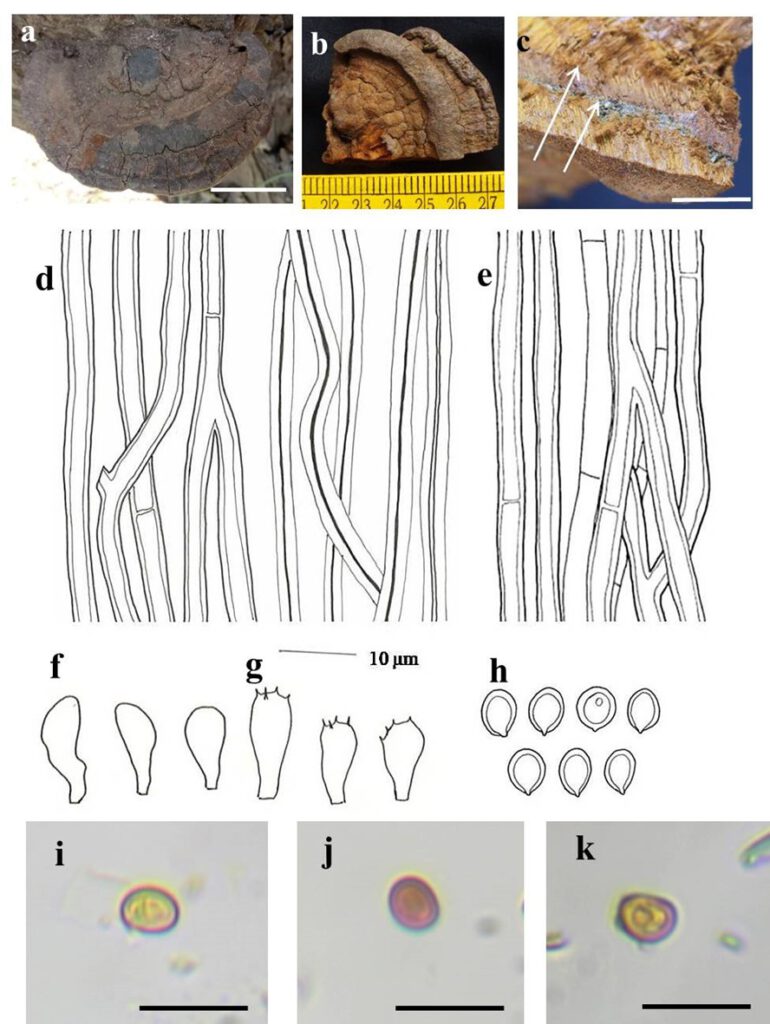Fulvifomes jawadhuvensis Kezo, K., Gunaseelan, S., & Kaliyaperumal, M., sp. nov.
MycoBank number: MB 558179; Index Fungorum number: IF 558179; Facesoffungi number: FoF 10745; Fig.1
Etymology: The species epithet “jawadhuvensis” referring to the locality of basidiomata collection.
Holotype: MUBL4011
Description: Basidiocarps perennial, solitary, pileate, sessile, light in weight, hard when dry. Pileus dimidiate, convex to meagrely ungulate, with no distinct crust, projecting up to 5.7 cm, 9.5cm wide and 3.4 cm thick near the base. Pilear surface velvety, light brown (6D6) to rust brown (6E8) and meagerly warted when young, on maturity pilei becoming rough, weakly rimose, concentrically, narrowly sulcate, weakly zonate. Margin entire, round to obtuse, brown (6E4) to dark brown (6F5), velutinate when young, developing into brownish grey (6F2) to greyish brown (6E3), glabrous on maturity. Pore surface raw umber brown (5F8) to brown (6E7). Pores round to angular, regular, 4–8 per mm. Dissepiments entire, thick. Context up to 2.7 cm, homogeneous, yellowish brown (5E8) to dark brown (6F7). Tubes yellowish brown (5D8) to light brown (6D6), up to 0.7 cm thick, tubes layers stratified, each strata 0.2 to 0.4 cm with thin layer of context in between.
Hyphal system strictly dimitic, Generative hyphae dominant; both skeletal and generative hyphae acyanophilous; tissue darkening with KOH without swelling. Context Generative hyphae, thin to thick walled, hyaline to yellow, simple septate, branched, 2–6.5 μm diam.; skeletal hyphae, thick-walled with narrow lumen, unbranched, yellowish brown, aseptate, 2–5.7 μm diam. Trama Generative hyphae, thin to thick walled, yellow to brown, septate, rarely branched, 2–5.2 μm dia.; skeletal hyphae, thick walled with narrow to wide lumen, yellowish brown, aseptate, unbranched, 2–5.2 μm dia. Setae, cystidioles absent. Basidioles dominant, clavate, 7.7–14 × 3.8–7.2 μm. Basidia clavate to broadly clavate, with four sterigmata, 8.5–15× 5–8.5 μm. Basidiospores broadly ellipsoid to subglobose, thick-walled, smooth, yellow in water, turning rust brown in KOH, (4.8–) 5.1–6.4 (–6.9) × (4.1–) 4.4–4.9 (–5.2) μm (n = 50/2), Q = 1.1–1.3, CB ̄, IKI ̄. Chlamydospores globose to subglobose, thick walled rust brown to reddish brown, 5.2 – 8.5× 4.1-7 μm, CB ̄, IKI ̄.
Specimen examined: INDIA, Tamil Nadu, Thiruvannamalai district, Jawadhu hills, Jamunamarathur, 12.64º 54’19.1”N 79º 18’33”E, on living angiosperm tree (Albizia amara), 09 Febraury 2018, Kezhocuyi Kezo (Holotype, MUBL4011).
GenBank numbers: ITS: MW040079, LSU: MW048886, TEF1-α: MW690924
Notes: F. jawadhuvensis shares similarity with F. grenadensis by having dimidiate to ungulate pileus, round to obtuse margin, absences of cystidioles, but the former lacks distinct crust after velvety pileus wears off and no. of pores per mm. Larger broadly ellipsoid to subglobose spores in F. jawadhuvensis differing from smaller spores in F. grenadensis (4–6 × 3–4 µm) (Ryvarden, 2004). The new Indian species shares other common characters with F. elaeodendri, F. hainanensis, F. thailandicus, in having dimidiate to ungulate basidiomata, zonate pileus with rimose patten (except F. hainanensis), pores per mm, distinctly thick-walled, colored basidiospores, absence of setae, but significantly varies basidiospores size and absences of cystidioles (Zhou, 2014; Tchoumi et al. 2020). F. jawadhuvensis and F. centroamericanus shares only dimidiate pilei and absences of cystidioles and differs in other features; the former varies in entirely from F. krugiodendrii (Ji et al. 2017).

Fig. 1: Fulvifomes jawadhuvensis (MUBL4011, halotype). a & b Basidiocarp. c Stratified tube layer. d Tramal hyphae. e Context hyphae. f Basidioles. g Basidia. h Basidiospore i Basidiospore in H2O. j Basidiospore in KOH. k Basidiospore in cotton blue. Scale: a = 3 cm. c = 1 cm. d–k = 10 µm.
